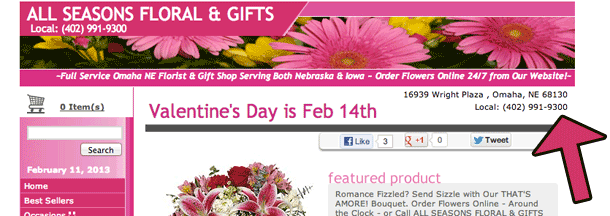Make Sure That Local Florist You Found On Google Really Is Local Image courtesy of (Kryptomaisonaut)
Let’s say that you want to order some flowers for your aunt in Omaha. You remember the frequent warnings on this site to go directly to a local florist, so that’s what you do. You type “florist omaha” into Google, scroll past the paid listings and the ones Google has plotted on a map, and choose a shop with a nice-looking website. Perfect! Only this “local” florist isn’t so local. You tried to make the right choice, but are hurting the very neighborhood flower shop you were trying to patronize when you typed those words in Google.
The business behind the site you’ve found is most likely a family-owned flower shop, but not one in your target city. Both you and that local florist that will actually deliver the arrangement have fallen victim to the fake local florist scheme.
Here’s how it works. Most businesses use SEO (search engine optimization) to guide you to their sites. That first page of “florist omaha nebraska” search results on Google is prime real estate, and companies work hard and/or pay big bucks to be the first listing that everyone sees, and the only listings that lazy people see. The entire workings of SEO are beyond the scope of this article, but the goal for fake local florists is simple enough: prepare pages for small and large cities and towns, and make sure those pages show up when shoppers go looking for florists in those places.
For example, here’s part of a landing page for Omaha.

The page where you land might name local landmarks and mention all of the locations in your city where they deliver: schools, hospitals, nursing homes, and colleges. That information is all for the benefit of search engines. The page might mention that the shop has a fleet of delivery vans, and that they deliver in [name of city in a different state], but these two facts aren’t necessarily related.
Once you click to order, though, the order won’t go to the shop whose name is on the site. Instead, your order goes directly to the wire service: let’s say that it’s FTD. The order goes through exactly as if you had gone right to FTD.com, minus a cut to the shop that runs the site. FTD turns around and routes the order to one of the local florists in their network. This is the part that has angry florists writing us to complain.
“Local florists loathe this company,” one local florist wrote to us about one fake local florist, “because nearly 40% of what the consumer spends actually makes it back to the local florist who fills and delivers the orders.” That’s not what people have in mind when they set out to find an actual local florist.
SO HOW DO I FIND AN ACTUAL LOCAL FLORIST?
Glad you asked. The obvious thing is to ask around: Talk to friends and family who live nearby. You can even take the lazy way out and just make a Facebook post. If you don’t know anyone in the area, try Yelp, or even use Google’s local listings: at least you can see on a map that the shop is located in the correct state.
Here are a few clues that your florist is really local: they list their street address on every page of their site. For example:

Local address and phone number, yay!
Here’s another example with an address and a local phone number.

The address doesn’t have to appear on every page, but it should be somewhere on the site. Check the “About” page, or the site’s home page.
Want more consumer news? Visit our parent organization, Consumer Reports, for the latest on scams, recalls, and other consumer issues.


